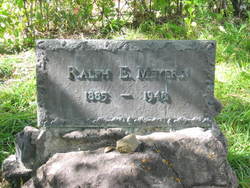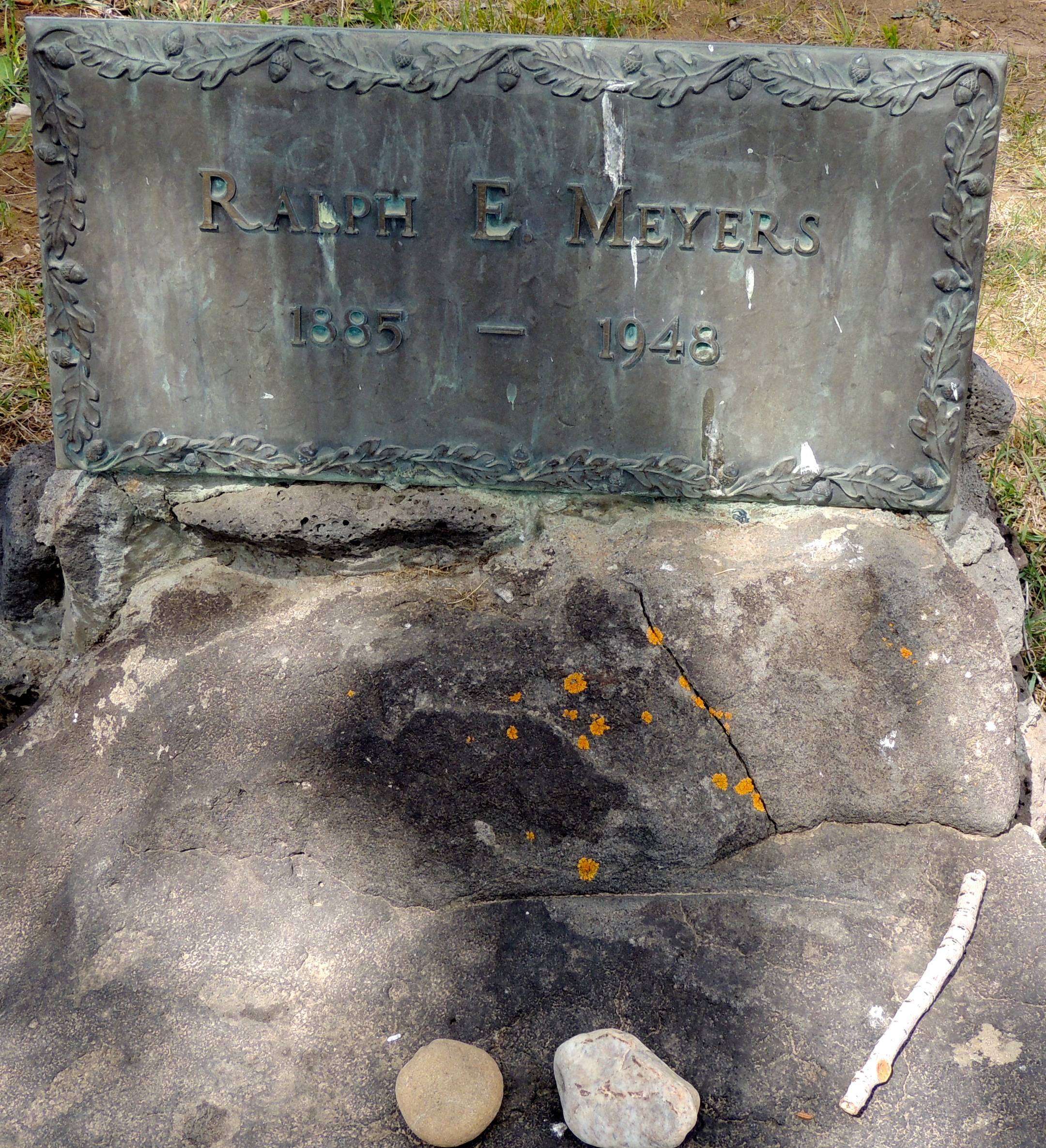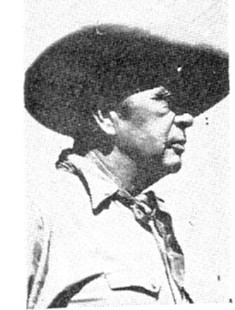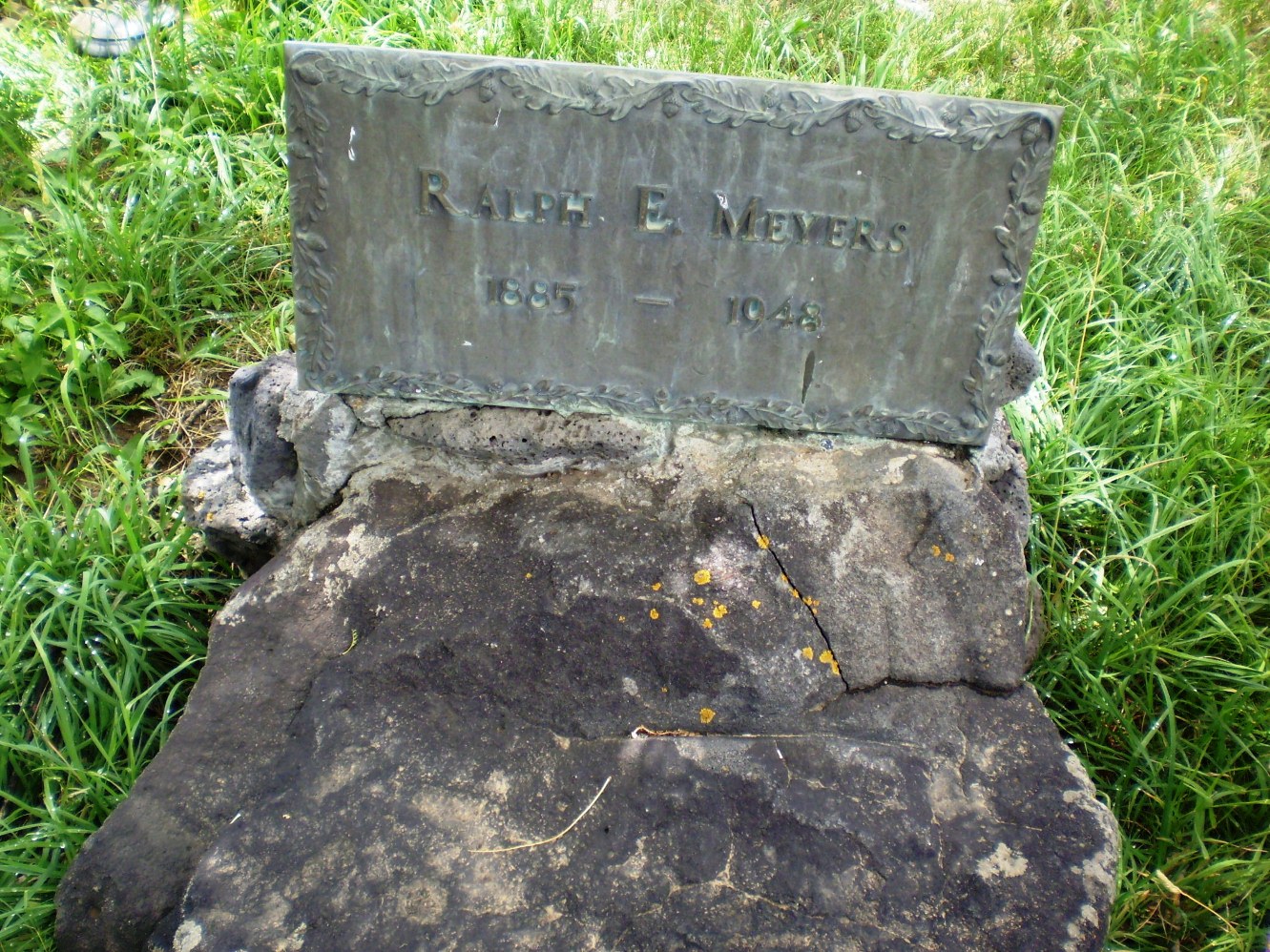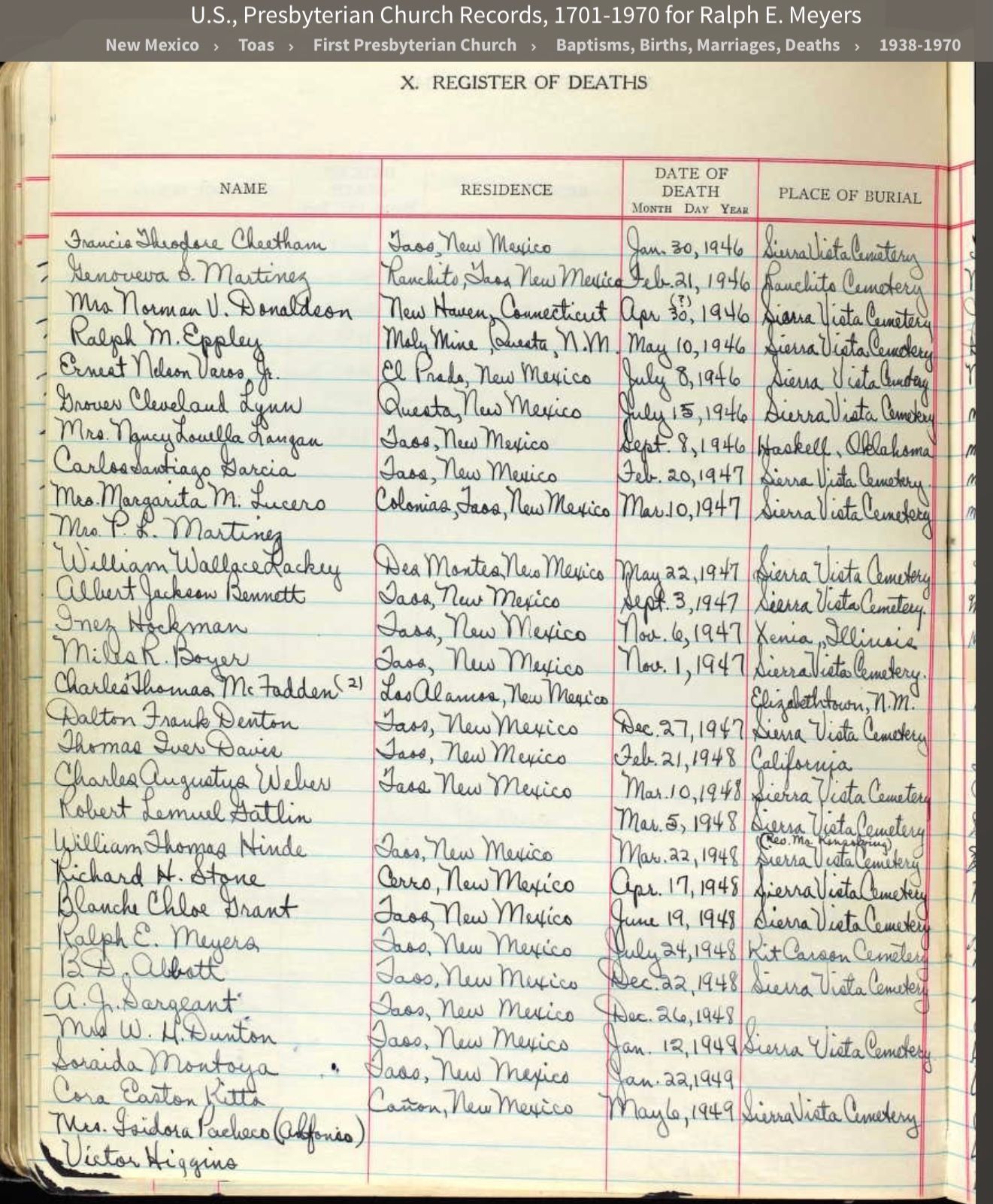(information contributed by #46553367)∼When Ralph was 2 yrs old (Circa 1887) they moved from Houghton to Colorado. At the age of 18 (circa 1901) Ralph came to Taos eventually moving here to be an artist. He had a very colorful history in Taos. On most of the historical publications here is Ralph's photo as a cover. Ouray Meyers
1900 Census shows Joseph 36, Oct 1863; Christine 35, Apr 1865; Ralph W. 15, May 1885; Hortense C. 13, Apr 1887; renting at 536 W. 14th Ave., Denver, Arapahoe, Colorado. All born MI. Joseph is a carpenter, Ralph is a clerk.
1910 Census shows Ralph 24, renting in Taos, Taos, New Mexico. He is a store keeper of curios.
1917 Draft Registration shows Ralph Waldo Meyers 33, living in Taos, Taos, NM. He is an artist, listing his nearest relative as Joseph Meyers, 1720 Hanover St. Aurora, Col. Description: tall medium build, brown eyes, brown hair.
1930 Census shows Ralph 43, owning ($3,000) in Taos, Taos, New Mexico. He is a dealer of curio goods.
1940 Census: Ralph Meyers 55, Rowena Meyers 30, Nina Meyers 4, Emerson Meyers 1. Home in 1940: Taos, Taos, New Mexico. Ralph born MI, Rowena born PA, kids born NM. Edu: Ralph 8th gr., Rowena C-2. Ralph was the mgr of a curiosity shop, Rowena was the clerk.
Find A Grave index:
Created by: Kevin Murphy
Record added: Oct 04, 2007
Find A Grave Memorial# 21953052
RALPH MEYERS (1885-1948), Plain air landscape, painted near Taos, New Mexico, oil on canvas over Board 10 X 13 inches, inscribed verso by the artist in pencil: "by Ralph Meyers, Winter of 1921, Early Spring of 1922"
Ralph Meyers was a well-known early day Taos Indian trader, forest ranger and painter who, without any training, did some remarkable New Mexican genre and landscape paintings and was, as Leon Gaspard called him, one of the finest colorists of the period.
Meyers grew up in Denver, where he was apparently heavily influenced by a number of prominent Western artists and frontier personalities, sufficiently so, that after numerous visits to the southwest soon after the turn of the century, he moved to Taos in 1909 and took a job as a fire guard on Taos land. He forged enduring friendships with the Indians, and opened an Indian trading post in 1912. His first exhibition was at the Museum of New Mexico in Santa Fe in 1917. He was not a prolific painter as the trading post was his livelihood. Meyers was immortalized as the Indian trader Rodolfo Beyers in Frank Waters's wonderful Book on early day Taos, "The Man Who Killed the Deer."
This information came principally from Dawdy, Doris Ostrander, Artist of the American West, Vol. II
Occupation: 1912, Indian Trader
Residence: 1910, Taos, Taos, New Mexico, USA
Taos and Sante Fe
History of El Rincon
Nina was the daughter of Ralph Meyers, the "Good White Trader" in Frank Waters Classic, The Man Who Killed The Deer. In 1909 Ralph opened The Mission Shop, the first Indian curio shop in Taos.
He traveled to the surrounding reservations, buying and trading with knowledge and understanding. Few white men were as well loved and accepted by the Taos Pueblo Indians. But this was not always the case.
When Ralph first arrived, he spent his days at the Pueblo, causing great suspicion among the Indians. They wondered who this strange white man was and what he wanted. Some believed that he must be after their women, so it was decided that they were either going to castrate him or offer him a bride. Fortunately for they chose the latter which he politely declined. He wished only to observe and enjoy the timeless and beautiful surroundings.
Ralph's descendants still maintain friendships and enjoy feast days with the descendants of the same families he befriended long ago.
This tree shaded cemetery within the Kit Carson Park in Taos, NM, is a park in itself with a well kept lawn and curving paths. It is found by taking the lane that turns north at the Indian Trading Post on Kit Carson Road. A monument at the north end of the cemetery and just outside the gate gives this history: "The original cemetery was established in 1847 when Dona Teodora MARTINEZ ROMERO donated land for the burial of American soldiers and civilians killed during the Taos Rebellion of 1847. The cemetery was 1st called El Cemeterio Militar. In 1852, additional land was purchased to enlarge the cemetery which was then the only burial ground for non-Catholics, and was known as the American Cemetery. In May, 1869, when the bodies of Kit Carson and Mrs. Carson were buried here, the cemetery was called the Kit Carson Cemetery. There are soldiers buried in this small cemetery who served during the Mexican War of 1846, the Taos Rebellion of 1847, the Indian Campaigns of the 1850's, the Civil War, the Spanish American War, World War I and World War II. Many of the early Taos traders, merchants, and members of old Spanish, French and American families are buried here." Recorded by Ella Louise May and Evelyn Bishop in August, 1979.
∼Information from First Presbyterian Church (Taos, New Mexico) - Baptisms, Marriages & Deaths 1933-1970
(information contributed by #46553367)∼When Ralph was 2 yrs old (Circa 1887) they moved from Houghton to Colorado. At the age of 18 (circa 1901) Ralph came to Taos eventually moving here to be an artist. He had a very colorful history in Taos. On most of the historical publications here is Ralph's photo as a cover. Ouray Meyers
1900 Census shows Joseph 36, Oct 1863; Christine 35, Apr 1865; Ralph W. 15, May 1885; Hortense C. 13, Apr 1887; renting at 536 W. 14th Ave., Denver, Arapahoe, Colorado. All born MI. Joseph is a carpenter, Ralph is a clerk.
1910 Census shows Ralph 24, renting in Taos, Taos, New Mexico. He is a store keeper of curios.
1917 Draft Registration shows Ralph Waldo Meyers 33, living in Taos, Taos, NM. He is an artist, listing his nearest relative as Joseph Meyers, 1720 Hanover St. Aurora, Col. Description: tall medium build, brown eyes, brown hair.
1930 Census shows Ralph 43, owning ($3,000) in Taos, Taos, New Mexico. He is a dealer of curio goods.
1940 Census: Ralph Meyers 55, Rowena Meyers 30, Nina Meyers 4, Emerson Meyers 1. Home in 1940: Taos, Taos, New Mexico. Ralph born MI, Rowena born PA, kids born NM. Edu: Ralph 8th gr., Rowena C-2. Ralph was the mgr of a curiosity shop, Rowena was the clerk.
Find A Grave index:
Created by: Kevin Murphy
Record added: Oct 04, 2007
Find A Grave Memorial# 21953052
RALPH MEYERS (1885-1948), Plain air landscape, painted near Taos, New Mexico, oil on canvas over Board 10 X 13 inches, inscribed verso by the artist in pencil: "by Ralph Meyers, Winter of 1921, Early Spring of 1922"
Ralph Meyers was a well-known early day Taos Indian trader, forest ranger and painter who, without any training, did some remarkable New Mexican genre and landscape paintings and was, as Leon Gaspard called him, one of the finest colorists of the period.
Meyers grew up in Denver, where he was apparently heavily influenced by a number of prominent Western artists and frontier personalities, sufficiently so, that after numerous visits to the southwest soon after the turn of the century, he moved to Taos in 1909 and took a job as a fire guard on Taos land. He forged enduring friendships with the Indians, and opened an Indian trading post in 1912. His first exhibition was at the Museum of New Mexico in Santa Fe in 1917. He was not a prolific painter as the trading post was his livelihood. Meyers was immortalized as the Indian trader Rodolfo Beyers in Frank Waters's wonderful Book on early day Taos, "The Man Who Killed the Deer."
This information came principally from Dawdy, Doris Ostrander, Artist of the American West, Vol. II
Occupation: 1912, Indian Trader
Residence: 1910, Taos, Taos, New Mexico, USA
Taos and Sante Fe
History of El Rincon
Nina was the daughter of Ralph Meyers, the "Good White Trader" in Frank Waters Classic, The Man Who Killed The Deer. In 1909 Ralph opened The Mission Shop, the first Indian curio shop in Taos.
He traveled to the surrounding reservations, buying and trading with knowledge and understanding. Few white men were as well loved and accepted by the Taos Pueblo Indians. But this was not always the case.
When Ralph first arrived, he spent his days at the Pueblo, causing great suspicion among the Indians. They wondered who this strange white man was and what he wanted. Some believed that he must be after their women, so it was decided that they were either going to castrate him or offer him a bride. Fortunately for they chose the latter which he politely declined. He wished only to observe and enjoy the timeless and beautiful surroundings.
Ralph's descendants still maintain friendships and enjoy feast days with the descendants of the same families he befriended long ago.
This tree shaded cemetery within the Kit Carson Park in Taos, NM, is a park in itself with a well kept lawn and curving paths. It is found by taking the lane that turns north at the Indian Trading Post on Kit Carson Road. A monument at the north end of the cemetery and just outside the gate gives this history: "The original cemetery was established in 1847 when Dona Teodora MARTINEZ ROMERO donated land for the burial of American soldiers and civilians killed during the Taos Rebellion of 1847. The cemetery was 1st called El Cemeterio Militar. In 1852, additional land was purchased to enlarge the cemetery which was then the only burial ground for non-Catholics, and was known as the American Cemetery. In May, 1869, when the bodies of Kit Carson and Mrs. Carson were buried here, the cemetery was called the Kit Carson Cemetery. There are soldiers buried in this small cemetery who served during the Mexican War of 1846, the Taos Rebellion of 1847, the Indian Campaigns of the 1850's, the Civil War, the Spanish American War, World War I and World War II. Many of the early Taos traders, merchants, and members of old Spanish, French and American families are buried here." Recorded by Ella Louise May and Evelyn Bishop in August, 1979.
∼Information from First Presbyterian Church (Taos, New Mexico) - Baptisms, Marriages & Deaths 1933-1970
Family Members
Sponsored by Ancestry
Advertisement
Advertisement
